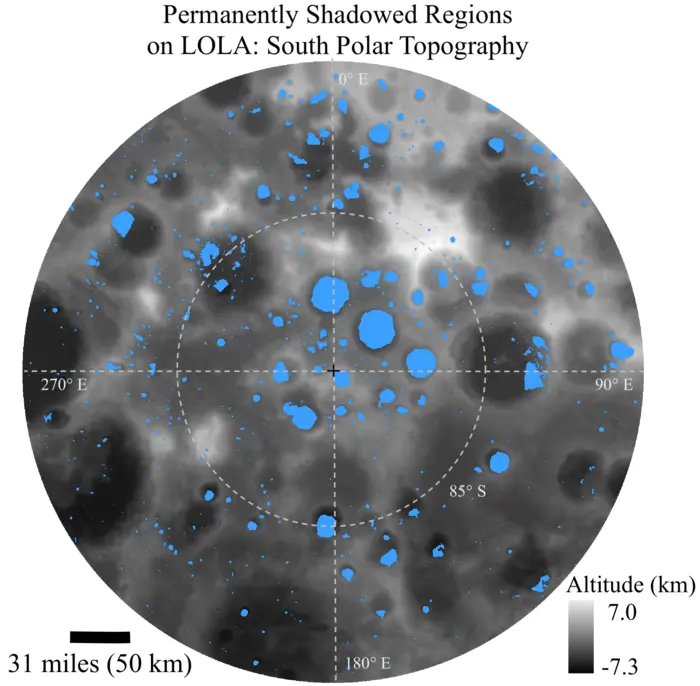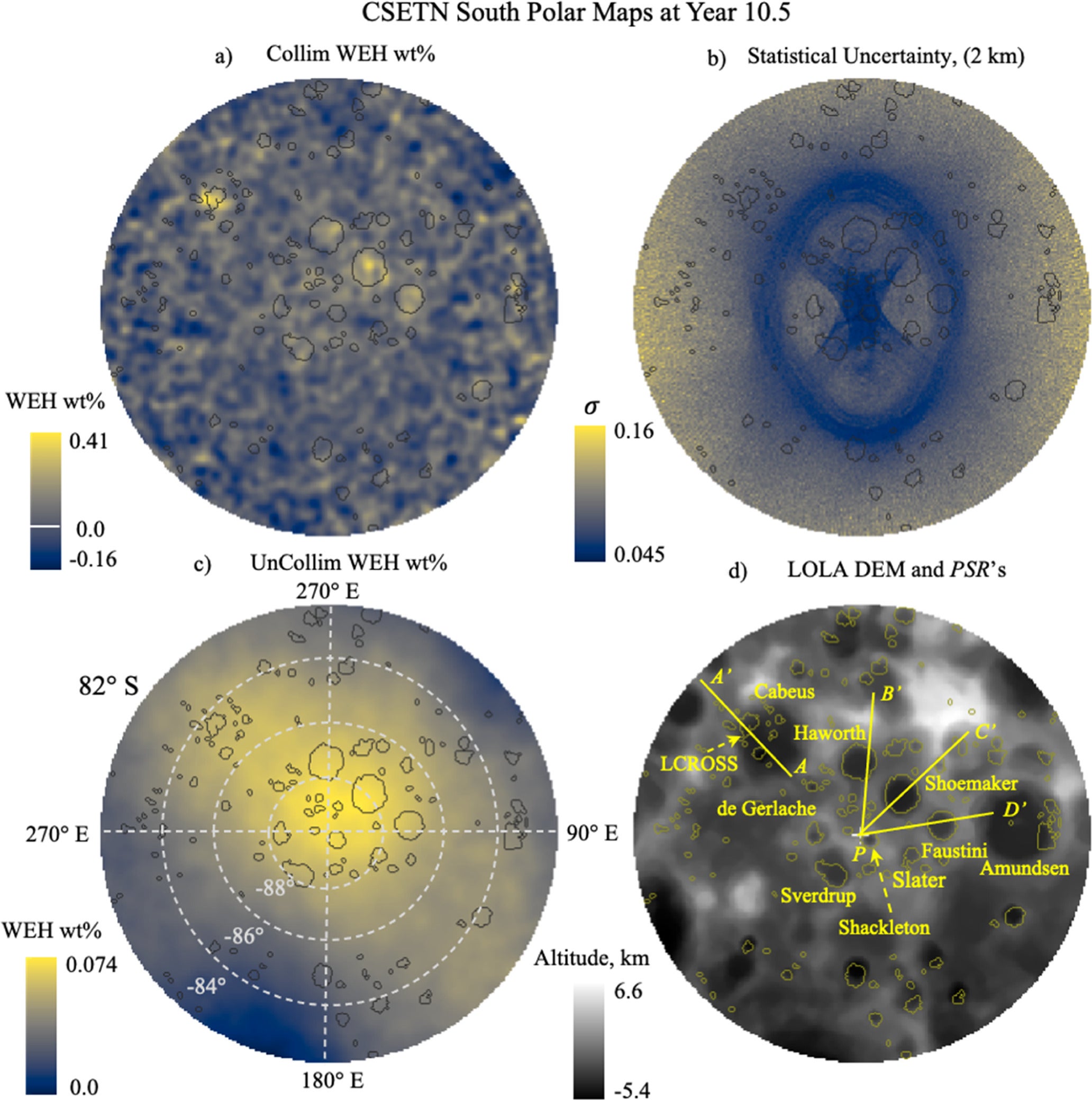The Moon’s permanently shadowed regions (PSRs), located at its poles, have long been a subject of fascination and scientific inquiry. These areas, shielded from direct sunlight for billions of years, are not only geologically unique but also hold significant promise for future space exploration.
Recent advancements in lunar exploration have revealed that these regions harbor deposits of hydrogen-bearing volatiles, such as water ice, in concentrations higher than previously imagined. Understanding these deposits is vital for the success of crewed lunar missions and the development of sustainable space exploration.
PSRs are formed due to the Moon’s slight axial tilt, which causes certain areas in polar craters to remain in perpetual shadow. These regions experience extreme cold, with temperatures below 75 Kelvin, creating conditions ideal for trapping water ice.
Unlike illuminated surfaces, where temperatures average 243 Kelvin, PSRs have negligible sublimation rates, allowing ice and other volatiles to remain stable over geological timescales.
The deposits in these shadowed regions are primarily derived from various sources. These include comet and meteorite impacts, chemical reactions between solar wind hydrogen and lunar regolith, and outgassing from the Moon’s interior.

Once released, water molecules travel across the lunar surface, often becoming trapped in the coldest parts of PSRs. This process has resulted in concentrated ice deposits that could serve as a valuable resource for future lunar missions.
Recent research has leveraged data from the Lunar Reconnaissance Orbiter’s (LRO) Lunar Exploration Neutron Detector (LEND) instrument to analyze hydrogen concentrations in the Moon’s south pole. Specifically, the Collimated Sensor for Epithermal Neutrons (CSETN) was used to detect hydrogen by measuring reductions in epithermal neutrons emitted from the lunar surface.
When galactic cosmic rays interact with lunar regolith, they generate neutrons. These neutrons lose energy when colliding with hydrogen atoms, enabling scientists to map hydrogen concentrations.
Findings indicate that hydrogen concentrations are highest in larger PSRs, such as those in Shoemaker, Haworth, and Faustini craters. These regions, with their low temperatures and stable conditions, likely harbor significant water ice deposits. Smaller PSRs, or those exposed to periodic sunlight, show lower concentrations, consistent with higher sublimation rates.
Related Stories
Dr. Timothy McClanahan, lead author of a recent study published in the Planetary Science Journal, highlighted the significance of these findings: “We find that there is widespread evidence of water ice within PSRs outside the South Pole, towards at least 77 degrees south latitude.”
This new understanding of the spatial distribution of hydrogen-bearing volatiles has implications for both scientific research and practical applications in space exploration.
The discovery of widespread ice deposits reshapes the landscape of lunar exploration. Water ice can be split into hydrogen and oxygen to produce rocket fuel, breathable air, and energy, significantly reducing the logistical challenges of transporting resources from Earth. It also provides shielding against space radiation, a critical factor for long-term human presence on the Moon.
To assess the viability of extracting these resources, the study developed models correlating hydrogen concentrations with PSR areas. The analysis revealed that larger PSRs contain approximately 0.28% water-equivalent hydrogen by weight. For every square meter of surface in these areas, it’s estimated that at least five liters of ice are present within the top meter of regolith.

Additionally, the research identified temperature gradients within craters that influence ice distribution. Poleward-facing slopes, shielded from solar radiation, exhibit higher concentrations of hydrogen-bearing volatiles than equator-facing slopes, which are warmer due to direct sunlight and secondary radiation.
Understanding PSR dynamics is not only critical for resource utilization but also offers insights into the Moon’s history and the processes shaping the inner solar system. The presence of water ice preserves a record of the Earth-Moon water budget over billions of years, providing clues to planetary formation and evolution.
The advancements in mapping techniques, including infrared and ultraviolet reflectance studies, complement neutron-based analyses.
While reflectance methods are sensitive to surface conditions, neutron detection provides a deeper view, capturing data from the top meter of regolith. This combination of techniques enhances the accuracy of resource assessments, aiding mission planners in identifying optimal landing sites for future exploration.
The integration of international efforts has also been pivotal. The LEND instrument, developed by Roscosmos, exemplifies the collaboration needed to tackle complex challenges in planetary science. These partnerships ensure that discoveries benefit humanity’s collective quest to explore and understand our celestial neighbors.
As NASA’s Artemis program and other international initiatives gear up to return humans to the Moon, the detailed mapping of PSRs and their volatile deposits will play a crucial role.
By identifying areas rich in resources, such missions can establish a sustainable presence on the Moon, paving the way for deeper exploration into the solar system.
Note: Materials provided above by The Brighter Side of News. Content may be edited for style and length.
Like these kind of feel good stories? Get The Brighter Side of News’ newsletter.
The post Scientists found far more water on the Moon than previously expected appeared first on The Brighter Side of News.